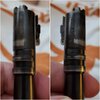Could be a stress concentration, just look at the sharp edges at the intersection of the pieces. My Statics teacher claimed that James Watt had an epitaph that said
"round your corners". That was before the internet and I can't find such a saying, but the logic is sound.
Bad metallurgy would be my guess. Bad metallurgy should not happen in today's world, but it does. As an example,
Kobe Steel was fined for fabricating data amid falling credibility of made-in-Japan products
Kobe Steel said in order to make it look like their products met their clients' specifications, they deliberately falsified the strength, durability and other data pertaining to the more than 600 products shipped to their clients.
Data, it was found, was manipulated at 23 domestic and overseas plants, with the company also admitting that more than 40 employees were involved in the falsification practice, which the firm said had been endemic in the company since the 1970s when the misconduct first began at its Tochigi Plant.
Companies ranging from automakers and airplane manufacturers, to defense equipment and Shinkansen bullet train makers, have been affected by the protracted scandal that has rocked the manufacturing world both domestically and globally.
There was a time, that is around 1900, when products were bought solely on reputation, and companies found, that if you did not have inhouse certification and inspection, the supplier would ship non conforming material because the buyer was too stupid to know the difference. For a time smart businesses had incoming inspection and independent verification, but that went away in the ISO 9000 world. And Kobe steel is an example of a practice that is much more wide spread than industry will admit.
I really thought Kobe Steel would go bust after this revelation but not so!. Stock was hovering around 1300-800 before the scandal, dipped, and now is around 504. It seems purchasing managers will continue to buy cheap product as long as Kobe CEO's weep, wail and claim they have learned their lesson!
Kobe Steel scandal: how did it happen?


